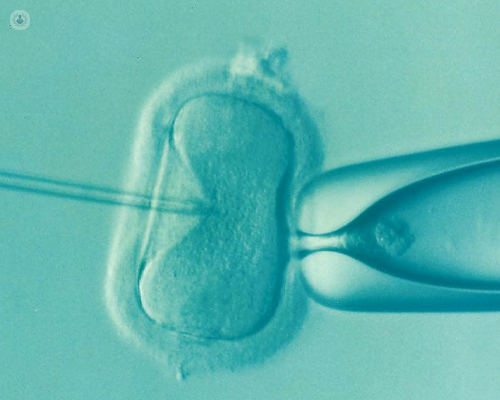All about IVF
Written in association with:Top Doctors speaks to highly-regarded gynaecology and fertility specialist Mr Julian Norman-Taylor about In Vitro Fertilisation (IVF), an option for couples or people who are having problems conceiving a child.
He guides us through the IVF process in detail, giving a step-by-step overlook of what's involved and discusses the success rate of what can be a lifeline for prospective parents struggling with fertility.

The established treatment of IVF, or In Vitro Fertilisation, is for women that are unable to conceive. Fallopian tubes are bypassed by removing eggs at the source, fertilising them in laboratory with a partner or donor's sperm.
Once fertilised, the embryos are carefully monitored. The healthiest and likeliest are placed into the uterus, which hopefully results in a normal pregnancy.
When is it appropriate to undergo IVF?
The original intention for IVF was to treat women with blocked fallopian tubes. However, sometimes it will be successfully used where there is no apparent problem with them and infertility remains unexplained. IVF may also be recommended if there is a problem with the sperm.
Is there a standard IVF process?
The treatment has become a routine procedure that has standard protocols. The details are tailored to suit the patient's particular situation, however. Mr Norman-Taylor will review your case as part of the run up to the treatment, which includes assessing previous cycles and hormone levels in order to individualise your IVF cycle.
Mr Norman-Taylor will discuss the practicalities of treatment, potential risks and complications with patients once a decision has been made with them to move forward with IVF.
The steps of the process:
- An appointment with one of the nursing staff at The Chiltern Fertility Clinic. They will work with your diary in order to plan the best time for beginning treatment. They will then conduct a review of paper work, consent forms and blood tests that are required by the Human Fertilisation and Embryology Authority (HEFA). Then, they will make it clear for patients how to do their injections and what the next steps are.
- The treatment stage of IVF. In order to stimulate the production of eggs, normal hormones are injected to stimulate egg production. Usually, the plan is to give slightly more hormones that the natural dose so the patient produces several follicles rather just one. Patients will be expected to administer these injections themselves but they won't be left to their own devices as the clinic will monitor your process. We do this via ultrasound scans to count the number of follicles and measure the thickness of the womb. There may also be blood tests to monitor oestradiol levels and other hormones.
- Depending on the speed of the body's response and which protocol the patient is on, they will take injections for 10 to 21 days. Once the follicles mature, patients will be given a final injection that starts the ripening process. Then, 36 hours later, the eggs will be removed by a process known as egg collection. Under sedation, they are removed through the vagina using ultrasound guidance. The process should last around 15 minutes. After the removal process, the eggs, or oocytes, are then transferred to the laboratory for fertilisation using sperm from the patient's partner or donor.
- The embryos are then incubated and carefully monitored in the laboratory until the optimum time for uterus implantation, between three to five days later. The best of the embryos are selected at this point. Dependent on your age and other factors, normally one or two will be transferred.
- If the remaining fertilised embryos are of good quality, they are frozen in case of the treatment needing to be repeated.
- The procedure is complete at this point. There is a two-week gap, however, before carrying out a pregnancy test. During this period, patients will normally be advised to take a hormone supplement. It's best for patients to avoid strenuous activity or sports while they are waiting, and take it very easy in the first week.
What's the probability of multiple pregnancy through IVF treatment?
The idea of a twin pregnancy is attractive for many couples; they will request two embryos are replaced. Twin pregnancies carry significantly higher risks than single ones, however, particularly premature birth.
When a couple have good quality blastocysts, our data shows how the chances of pregnancy are almost the same whether one or two embryos are replaced.
The decision of how many embryos to be replaced is very difficult. It's important that a decision will need to be reached despite this, alongside the advice that you are given on the day of placement.
What are the success rates of IVF?
Chances of conceiving through IVF depends upon several factors. Most importantly the age of the female patient. Mr Norman-Taylor's clinic’s verified published pregnancy rates have been in the top per centile for more than 20 years.
Want to know if IVF is the most suitable fertility treatment for you? Arrange an appointment with Mr Norman-Taylor via his Top Doctors profile.


